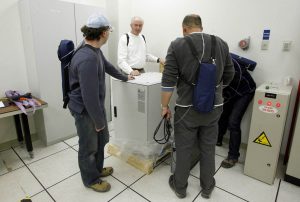Dr. Ir. Omid Noroozian, an associate scientist and senior research engineer with NRAO’s Central Development Laboratory, was honored with NASA’s prestigious Nancy Grace Roman Technology Fellowship in Astrophysics.
Select :
aasactive galactic nucleusALMAanniversaryARDCasteroidasteroidsAtacamaAtacama Large Millimeter/submillmeter arrayAUIaui programAUI Scholarshipawardsbaselinebinarybinary starsblack holeblack holesblazarBroader Impactsbrown dwarfCaltechcasaCDLcensusCentral Development LaboratoryCepheus acfachandracoma berenicesComa clustercometscosmic explosioncosmologycryoCSOdark matterdead galaxyDecadal Surveydeep fielddeep field imagingdftaudigital backenddistant galaxydiversityearly universeEHTEMSequityeventexoplanetexoplanetsfast radio burstFast Radio Burstsfirst fringesflarefotaufrbfringesfundinggalaxiesgalaxies mergergalaxygalaxy clustergalexgamma ray burstgbogbtgravitational lensgravitational wavesgreen bank observatorygreen bank telescopeH20HAM Radiohelical magnetic fieldhonorsHubbleHugheshvachw2hydrogenimage contestinclusioninternational women's dayIoJansky FellowshipsJansky Lecturejetjet collimationjetsJupiterLeroyLGBTlocal oscillatorlow noise amplifierm83M87magnetarMagnetarsmagnetic fieldsmaserMilky Waymolecular cloudsmoumtexNACnasaNational Astronomy ConsortiumNational Science Foundationnear earth objectsNEOsneutron starsneutron-star mergernglcngVLANINENMnraoNRQZNSFNSF NRAOODIopen houseOrionparkes radio observatorypawseypeoplePHANGSplanetary defensePlanetary Radarplanetary scienceplasmaPostdoctoral researchPRIDEprotoplanetary diskprotoplanetsprotostarprotostarsprotostellar jetPROVOCAproxima centauripulsarqorvoquasarradarradio telescoperam pressure strippingraytheonreceiverreceiver upgradeREUrixindustriesSchinnererscholarshipscience casesSETIsgrASMBHsofiasoftwareSolar Systemspectrumspiral galaxiesstar deathstar factorystar formationstarbirthstarsstellar flarestellar nurseriesSTEMsummer researchsupernovasupernova remnanttidal disruption eventstradestradesmenunmupgradeusnovery large arrayvery long baseline arrayviaVLAvla open housevlassVLBAvlbivndawaterxkaxray


ALMA Board Approves Band 1 Receivers
ALMA Band 1 receiver approved by ALMA Board.

ALMA Upgrade to Supercharge Event Horizon Telescope, Astronomy’s ‘Killer App’
Upgrade to ALMA soon will help astronomers make the first images of a black hole as part of the Event Horizon Telescope.





